PPC
Biggest Trends, Challenges, & Strategies for Success

Pay per click (PPC) advertising is a big deal in digital marketing, especially in the retail world. As 2024 heats up, we’re not just talking about simple ad placements and bids; it’s all about smart technology, understanding your customers, and getting creative with your strategies.
Whether you’re a pro in digital marketing or just starting to explore ecommerce ads, keeping up with PPC trends is crucial. This guide is here to help you out.
Contents
Biggest trends in PPC for retail
Let’s dive into the PPC scene for retail in 2024. Things are getting exciting with Google’s ad platform evolving rapidly, especially with its use of AI and machine learning.
Increased use of AI and machine learning
Often, we talk about AI as if it’s one big thing, but it’s more nuanced. AI is the broader concept of machines being able to carry out tasks in a way that we’d consider “smart.” Within this, machine learning is a specific subset of AI that trains a machine how to learn. In the PPC world, this distinction is key.
This year, AI will be transitioning away from merely a novelty. It is becoming smarter, a trend we can refer to as Smart AI. This new phase of AI is more targeted and informed, indicating a significant evolution in how AI systems are developed and applied.
🤖 Want to use AI the right way? Free download >> Emergency Guide to AI in Marketing
AI in ad targeting
AI’s role in PPC is about understanding and predicting. It sifts through tons of data to figure out what consumers are looking for, then predicts their buying patterns. This means your retail PPC ads are more likely to show up for people who are genuinely interested in what you’re selling.
Machine learning in real-time optimization
Machine learning steps in to continuously improve how your retail ads perform. It adjusts bids, manages budgets, and identifies trends that you might not notice. It’s like having an assistant who’s always optimizing your campaigns, ensuring they reach the right audience effectively.
Mastering these technologies is crucial for digital marketers in retail. It’s not just about using these tools; it’s about understanding them deeply and leveraging their strengths to boost your PPC campaigns.
Top PPC strategies for retail in 2024
Here are four essential PPC strategies for retail digital marketers:
1. Try Demand Gen campaigns
Recently, Discovery Ads campaigns were automatically upgraded to the Demand Gen campaign type in Google Ads.
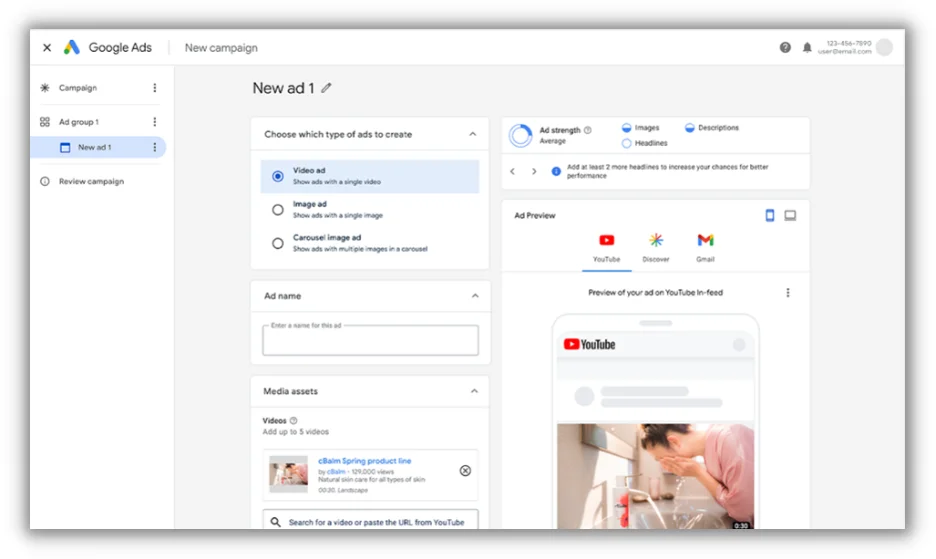
Demand Gen is more than just an upgrade–it’s a game-changer in winning social budgets for Google. Early testers have shown that Demand Gen campaigns deliver better performance when compared to Discovery Ads. That means more qualified traffic, more conversions, and more growth for your business or clients.
2. Embrace automation and smart bidding with Performance Max
In the realm of PPC, automation is crucial. Performance Max, a feature of Google’s automated bidding system, helps optimize ad placements across various channels. At the same time, new Demand Gen formats on Google platforms are changing the game. By using these engaging and visually appealing ads, you can attract potential customers right at the onset of their search journey.


Combining Performance Max with innovative ad formats ensures your ads are not only seen but also resonate with your target audience.
3. Experiment with AI
AI, specifically through tools like FeedGen, is revolutionizing how product feeds are optimized. By employing Google Cloud’s Large Language Models, like Bard, FeedGen enhances product titles, descriptions, and attributes, offering a unique way to experiment with AI in your marketing strategy. For integration instructions, visit here.
4. Explore ecommerce on diverse platforms with cross-channel and omnichannel strategies
Expand your PPC horizons beyond Google Shopping. Embrace the dynamic advertising opportunities on platforms like TikTok, Facebook, and Instagram. Each of these platforms caters to different audience segments and offers unique ways to engage with potential customers.
Integrating these platforms into your advertising mix, alongside traditional channels, creates a holistic and impactful PPC strategy for retail that aligns with the multifaceted nature of today’s consumer behavior.
Implementing these strategies in your PPC campaigns can lead to more effective and engaging marketing efforts, keeping you ahead in the competitive retail sector of 2024.
🛑 Worried you’re wasting spend in Google Ads? Find out with a free, instant audit >> Google Ads Performance Grader
Common challenges and solutions in PPC for retail
Let’s take a look at the common PPC challenges (and the solutions to these challenges) that retail advertisers run into.
Challenge 1: Ad saturation and viewer fatigue
The digital world is awash with ads, making it a challenge for retailers to stand out and capture attention, often leading to viewer fatigue.
Solutions
- Create unique, engaging content: Develop content that answers potential customer queries, positioning your brand as a solution at the top of the funnel. Focus on being helpful and informative.
- Try dynamic ad formats and personalization: Use diverse ad formats and tailor your messaging to connect more effectively with your audience. Personalization can help break through the clutter.
- Experiment and test: Try different creative approaches to discover what resonates best with your audience. Keep your content fresh and engaging.
- Apply the 80/20 rule: Dedicate most of your content to educate and engage (80%) rather than direct selling (20%). This approach can build trust and provide value to your audience.
- Be consistent with content creation: Regular updates and new content can keep your audience engaged and interested.
- Monitor and adapt based on metrics: Regularly check your campaign metrics to understand what’s working. Analyze data like click-through rates, conversion rates, and engagement levels. Double down on strategies and content types that show success. Being data-driven in your approach allows you to refine your tactics continuously and do more of what works best.


Take a look at our search advertising benchmarks to see how your metrics compare.
By combining these strategies, retailers can better navigate the challenges of ad saturation and viewer fatigue, making their PPC campaigns more effective, engaging, and relevant to their target audience.
Challenge 2: Balancing automation and human insight
While automation in PPC is powerful, an over-reliance on it, such as solely depending on Google Ads’ auto-apply settings, can lead to missed opportunities for optimization. Automation can sometimes miss the subtleties that a professional digital marketer can catch.
Solutions
- Think of AI and automation as assistants, not replacements. As a professional digital marketer, your experience and insights are invaluable. Use automation tools for efficiency but maintain control and oversight for strategic decisions.
- Regularly review the performance of your campaigns with a critical eye. Remember, the auto-apply settings in Google Ads might not always align with your unique goals.
Your role is to guide these tools, making manual adjustments and infusing your campaigns with the strategic depth that only human experience can provide.
Challenge 3: Measuring and attributing ROI accurately
Accurately tracking the return on investment (ROI) from PPC campaigns can be complex, especially when dealing with multiple channels and customer touchpoints.
Solution
Invest in advanced analytics tools like Google Analytics 4 (GA4), which is designed with privacy in mind. GA4 offers features such as default IP anonymization, region-specific controls for features like Google Signals, and the ability to mark events as non-personalized ads. Additionally, you can set shorter data retention periods and have more accurate data deletion options, including deleting data for individual users upon request.
These features not only enhance privacy compliance but also provide a clearer understanding of attribution models. This approach allows for more effective tracking of the customer journey and helps in attributing conversions accurately to the right campaigns, all while maintaining user privacy.
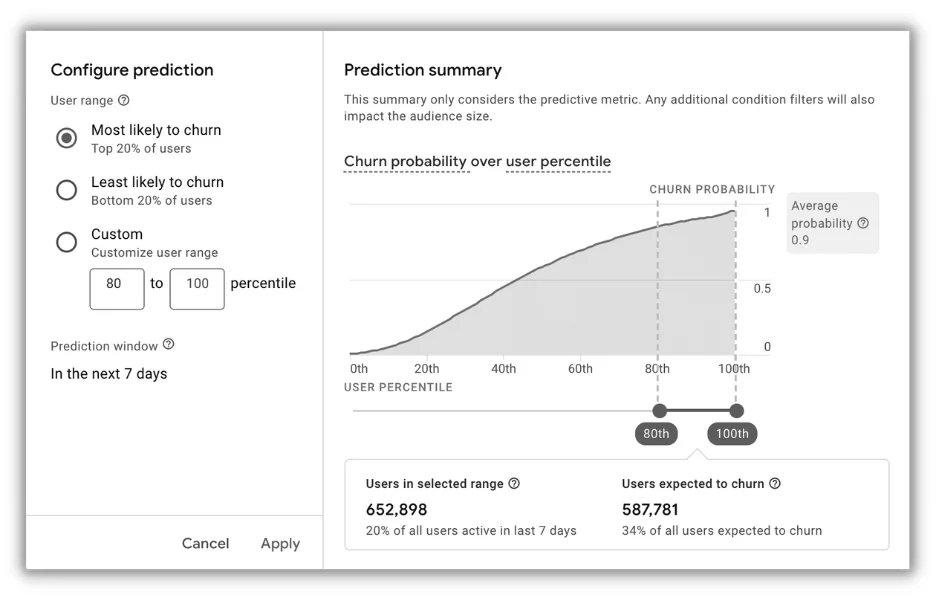

Challenge 4: Keeping up with rapid technological changes
The pace of change in PPC tools and algorithms can be overwhelming, especially for smaller retailers with limited resources.
Solution
Stay informed about industry trends and updates. Consider joining online communities, attending webinars, or collaborating with digital marketing experts to keep your strategies current.
Challenge 5: Navigating privacy regulations and data restrictions
Retailers are increasingly challenged by the need to balance effective ad targeting with strict privacy regulations like GDPR and CCPA.
Solution
Emphasize transparency and user consent in your advertising strategies. Utilize Google’s Consent Mode and adopt a consent management platform to ensure compliance with privacy laws.
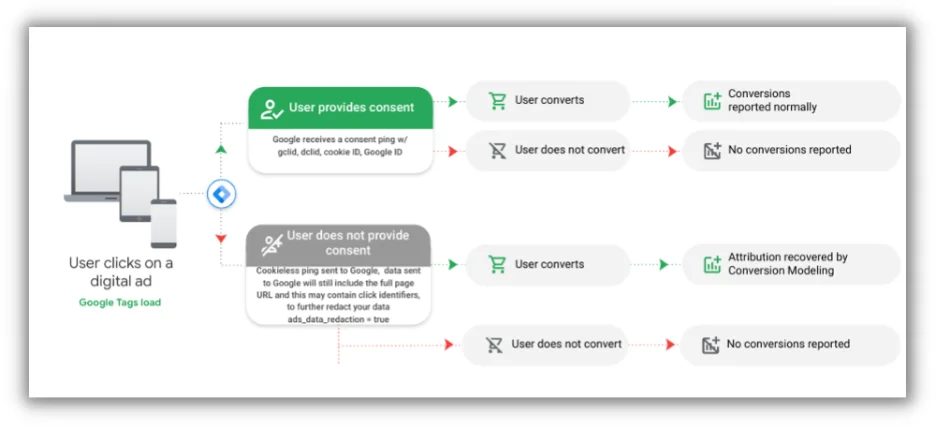

By leveraging contextual targeting and first-party data, you can still deliver personalized experiences while respecting user privacy. Investing in privacy-compliant tools and practices not only builds trust with your audience but also ensures the sustainability of your ad campaigns in a privacy-focused world.
Make the most of your PPC for retail campaigns
Navigating the PPC landscape in 2024, especially in the retail sector, is both challenging and exciting. The key to success lies in striking the right balance between leveraging advanced technology and maintaining the human touch that defines your brand. By focusing on creating unique, engaging content that educates and resonates with your audience, personalizing your messaging, and using dynamic ad formats, you can stand out in a crowded digital space. Remember, it’s not just about catching the eye but also about building lasting relationships with your customers.
Embrace tools like Google’s Performance Max and AI-enhanced solutions like FeedGen for efficiency and effectiveness, but don’t forget the value of your professional insight and experience. Always be ready to adapt, innovate, and refine your strategies based on real data and customer feedback.
In the fast-changing digital marketing world, thriving retailers recognize the need to adapt, embrace new tech, and stay true to customer values.
Here’s to making your PPC retail campaigns impactful, not just successful!
PPC
Marketing Funnel: Stages, Strategies, & How It Works

While everyone has different marketing strategies, there is one thing that every marketing plan should have: the marketing funnel.
Understanding your marketing funnel is the key to identifying the best content and strategies for moving customers along in their journey.
In this post, I will break down everything you need to know about the marketing funnel, including what it represents for your business, why you need one, and how to use it to maximize your success.
Contents
What is the marketing funnel?
The marketing funnel represents a consumer’s journey from being unaware that you exist to becoming a customer. It’s often broken up into four different stages, but the number of stages and names of those stages vary depending on who you talk to. One of the most widely accepted sets of stages is as follows:
- Awareness
- Interest
- Desire
- Action
We’ll talk more about each of these phases later in this post.
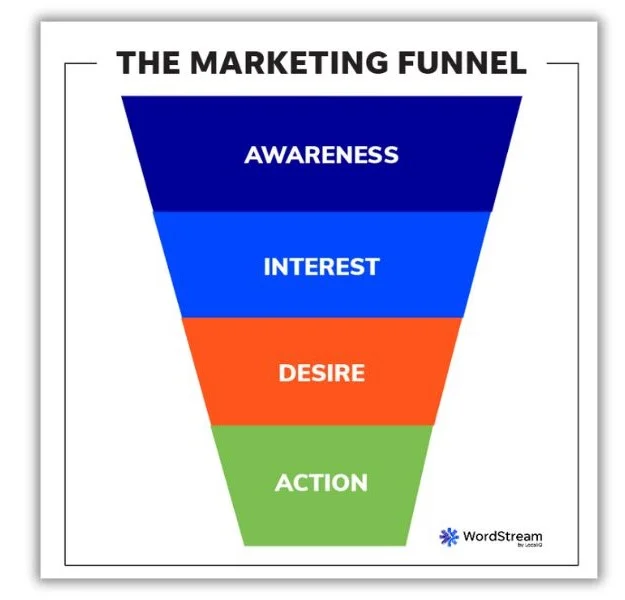
The marketing funnel is shaped like a funnel because you naturally get drop-off along the way. Not everyone who becomes aware of your business, product, or service will complete the journey to becoming a customer. The idea is to maximize that number, of course.
🛑 Want to improve every stage of your marketing funnel? Download 130+ of the Best Online Marketing Tips for Generating More Traffic, Leads, & Sales and move more people from awareness to purchase.
Why is the marketing funnel important?
You need a marketing funnel because most people are not ready to buy right away. This has always been the case to varying degrees for different industries. But it’s more true than ever because consumers have so many options now and even more tools for researching and vetting.
Let’s go over why the marketing funnel helps to account for this buying behavior.
Guides your content strategy
Because customers have different intents at each of the stages in the buying journey, the content that will be most effective at influencing them at each of those stages will be different. With a marketing funnel, you can then create a content marketing funnel so that you’re equipped to move your leads through the journey.


Increases conversions
A marketing funnel increases conversions because, without one, you’re asking people to make a massive leap from being aware of your brand to becoming paying customers without guidance. This rarely happens, so your conversion rates with this approach will be super low.
With a marketing funnel, you start with low-friction education. Each subsequent offer requires a little more commitment and buy-in than the last. Now, you’re increasing conversion rates at each stage, bringing more leads to the finish line.
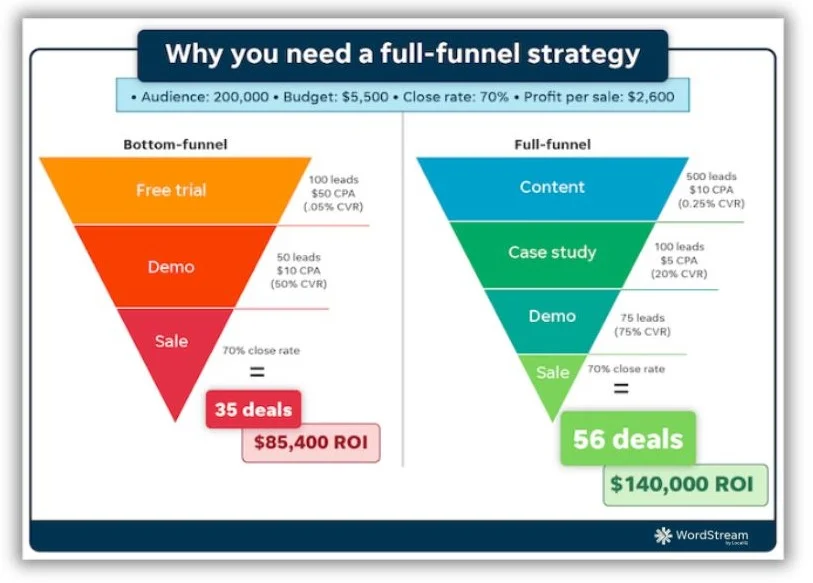

Identifies problem areas
As we just covered, a marketing funnel takes your one conversion action (becoming a customer) and breaks it into a series of smaller conversion steps. This way, you can establish benchmark conversion rates at each stage, which will allow you to monitor and adjust accordingly. For example, if you’re generating many good-quality leads but your demo conversion rate is lacking, you may want to revisit your bottom-funnel and sales enablement content.
What are the stages of the marketing funnel?
Now that you understand the marketing funnel and why it’s important, let’s review the different stages of the funnel and the best types of marketing strategies for each stage. Note that you can produce the same content formats at any stage of the funnel: blog posts, downloadable PDFs, website pages, ads, emails, and videos—what differs is the content topic.
Awareness stage
In the awareness stage of the marketing funnel (also called “top of funnel” or “TOF”), the consumer is aware of their pain points but not aware of your business. They may not even be aware of the product or service you offer. Your goal is to get them to understand the problem behind their symptoms, to learn that there are solutions, and to become aware that you exist.
What the consumer is doing: Searching online for information about their pain points. Their keyword intent is informational, so they’re searching things like “how to increase/decrease/improve X” and “why is X happening.”
Best strategies: Offer advice, be helpful, and educate people on the root problem in this content. Use blog posts, ebooks, PR, events, newsletters, guest blogging, social ads for guides, display ads, and more.
Example: My company, Hatch, is a text automation platform for contractors. But contractors in the awareness stage aren’t looking for or interested in this. They’re interested in their symptoms: leads not responding to their calls and sales representatives burning out. So, we have a blog post on reasons your leads aren’t responding.
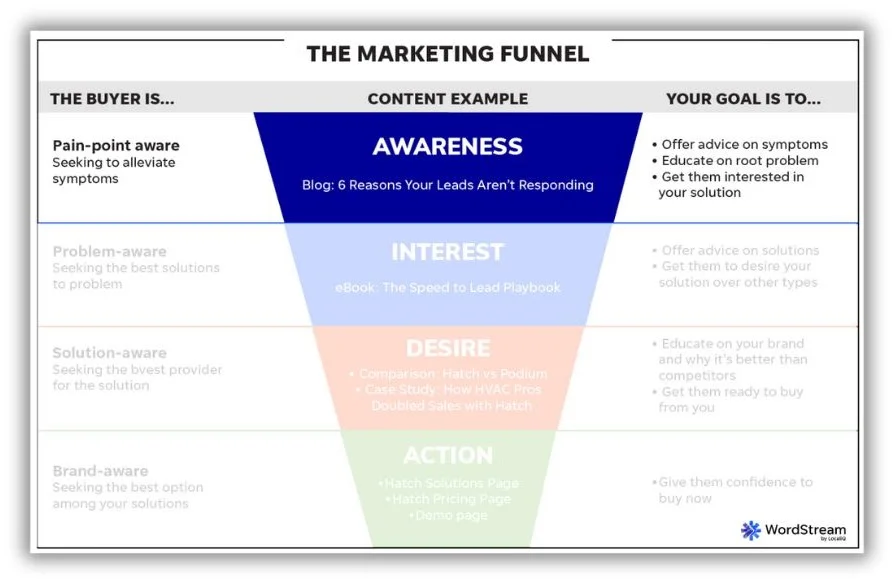

💡 Master the awareness stage with the free Definitive Guide to Brand Awareness: Top Strategies, Examples, & How to Measure Success.
Interest stage
In the interest stage of the marketing funnel, the customer is aware of the root problem behind their symptoms and that there are solutions to this problem—yours being one of them. Your goal is to get them interested in the solution you offer. This doesn’t necessarily mean your brand, just the type of solution.
What the consumer is doing: Searching for the best solutions to their problem. Their keyword intent is still informational, but the keywords are less about symptoms and more about solutions.
Best strategies: Provide education on the different solutions and offer content illustrating why yours is the best. Try free trials, product guides, explainer videos, buying guides, and search ads.
Example: Continuing with the Hatch example, the customer in this stage of the funnel is now aware that the problem behind the symptom of leads not responding is that they’re not reaching out fast enough. So, one of our middle-of-the-funnel pieces of content is this Speed to Lead Playbook. It’s got strategies for reaching out to leads faster, with automated texting (the solution Hatch provides) being one of those strategies.
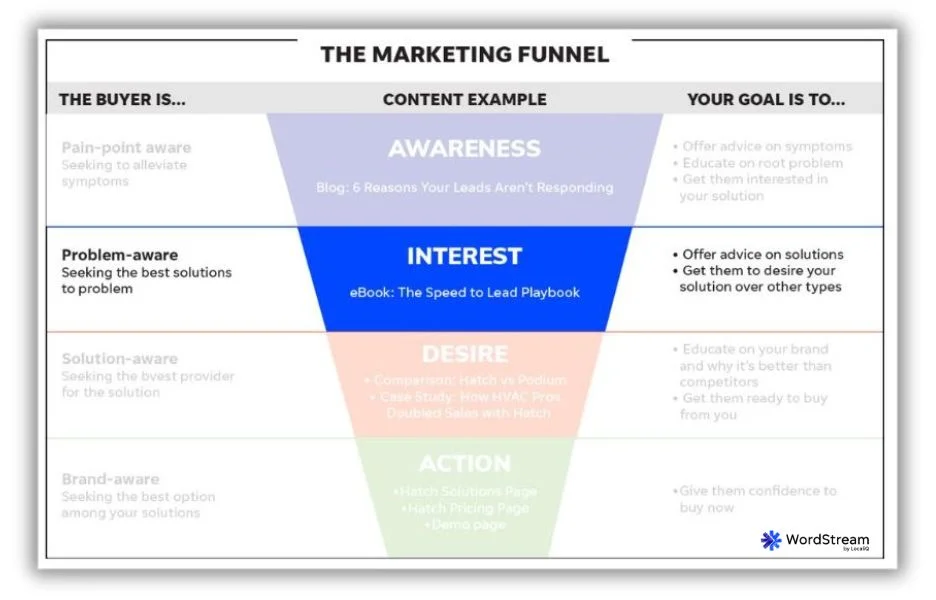

Desire stage
At the desire stage of the marketing funnel, the customer is aware of the problem and interested in your particular solution. Your goal is to convince them that your brand is the best provider of that solution.
What the consumer is doing: Evaluating your business, comparing it to competitors, asking friends about you, and reading reviews. Their keyword intent is commercial, which means they’re searching with terms like “reviews,” “compare,” “vs.,” “alternatives,” and “best.”
Best strategies: Show what makes you different from competitors. You can do this with one-pagers, comparison pages, case studies, testimonial pages, internal battle cards, and reviews. Also, focus on telling a compelling brand story that helps you to stand out.
Example: Still using our Hatch example, this post on Hatch vs. Podium examines how these two texting platforms differ and the types of businesses each one is best suited for.
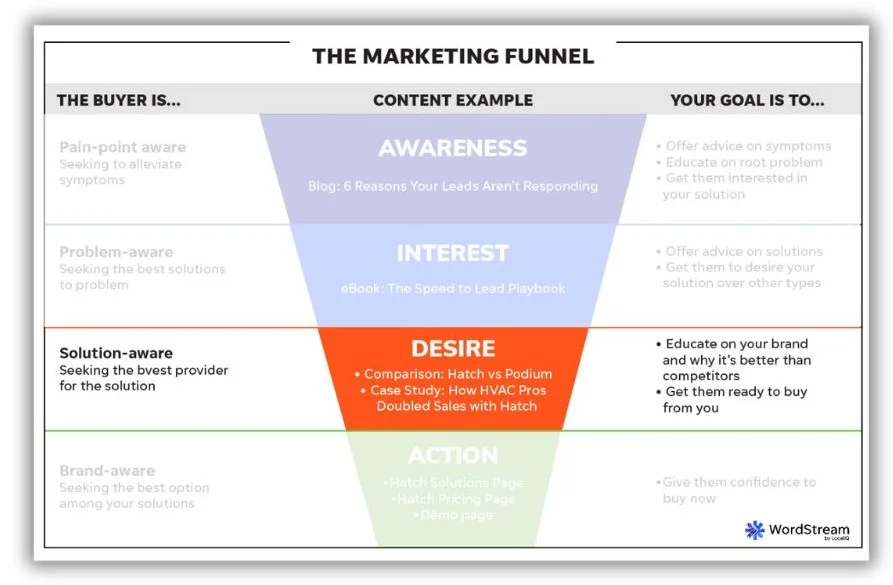

Action stage
In the action stage of the marketing funnel, the customer is now confident that you are the best solution for their problem. Your goal is to get them confident enough to buy now.
What the consumer is doing: Evaluating the specific offerings you provide, comparing packages, calculating prices, and doing final vetting. Their keyword intent is navigational (they’re returning to your site and review platforms) and transactional (they want to know how/where to buy from you).
Best strategies: Show why you are worth the price, why they should act now, and appeal to their emotions. Offer promotions, use compelling calls to action, and write persuasive copy that sells.
Example: The Hatch demo page or pricing page would be action-stage pieces of content.
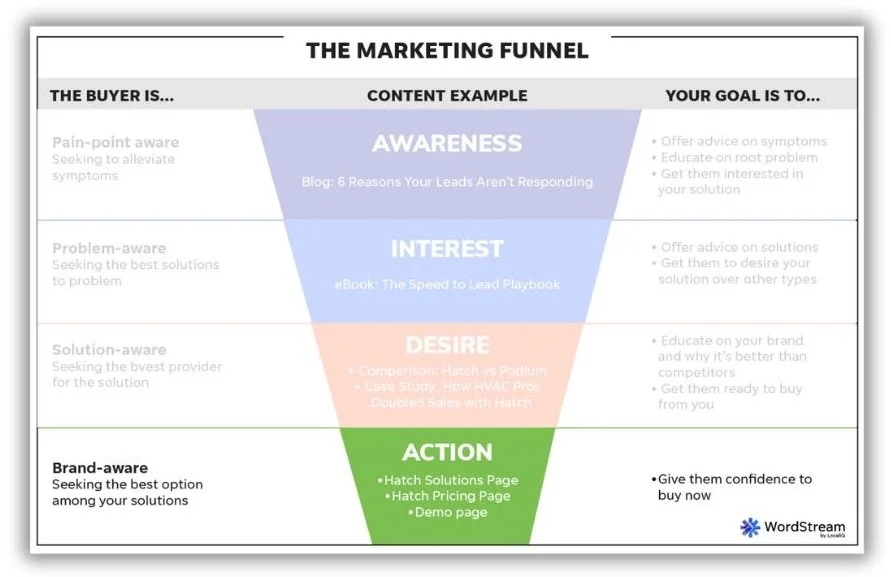

Maximize conversions with your marketing funnel
No matter what kind of business you have, it’s imperative that you understand what your marketing funnel looks like. Take the time to map yours out so you can increase conversion rates, create a better customer experience, and ultimately gain more customers. And if you identify problem areas, let us show you how we can help move prospects through each stage of your marketing funnel.
PPC
5 Ways To Use Google Gemini For PPC Inspiration

AI is changing digital marketing. For most companies that means embracing tools like Google Gemini to simplify day to day tasks and improve efficiencies.
If you aren’t using AI in the PPC space, then you could be missing out on the opportunity to drive efficiencies, get a whole bunch of keyword, campaign and copy inspiration, and claim some valuable time back from your day.
If you’re looking to get started here are five ways that you can integrate Google Gemini into your Google Ads campaigns in order to maximise efficiency and drive growth:
1. Ad Copy Inspiration
Ad copy is probably the most common reason PPC execs use Google Gemini. This is for its ability to generate significant variations on ad copy quickly, making it a valuable tool for A/B ad testing and taking that ad copy to the next level.
Re-writing, updating and coming up with inspiration for new ad copy used to be quite a laborious task – but not with Gemini. With the right guidance and input it can provide you with ad copy variations in next to no time.
There are a number of different ways you can use Gemini to support your ad copy creation – from the AI-integrated options within the Google Ads interface, through to asking it directly from the main Gemini platform. Both of these are effective and can save substantial time and also provide you with ad copy ideas.
To get the most out of it, make sure that you clearly input any restrictions (e.g. the 30 character headline limit) and target the focus keywords that you want to generate ideas around. In this example we are researching for our own Google Ads campaigns:
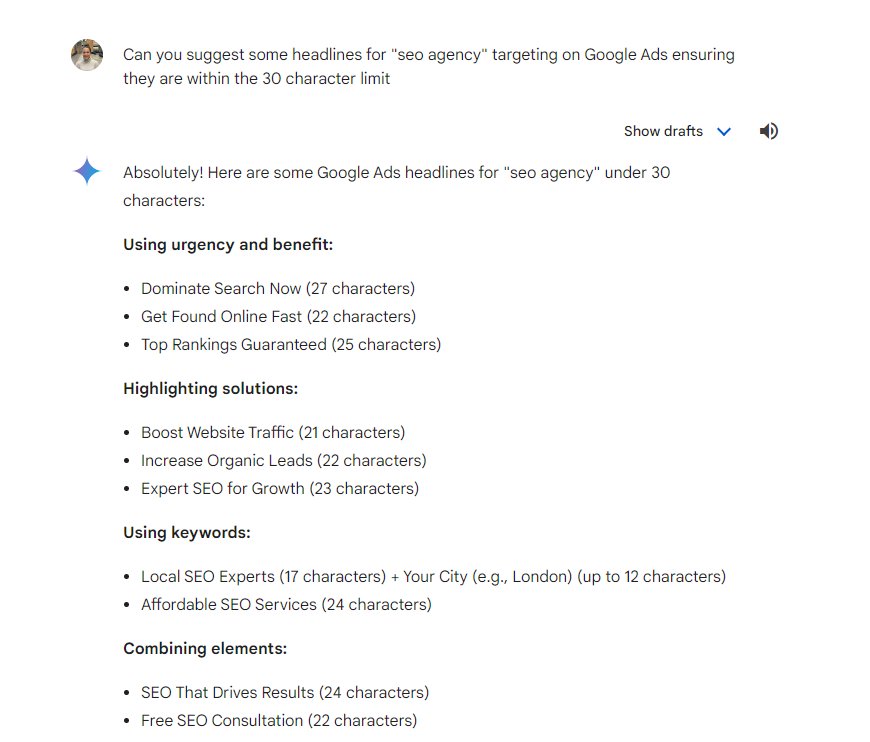
You can even specify the “type” and “approach” of ad copy you are looking for to ensure that you’re meeting your audience’s needs effectively. In the next example, we were doing research for our own Google Ads campaigns, where we are focusing on an emotion-driven “curiosity-inducing” approach, designed to improve CTR:
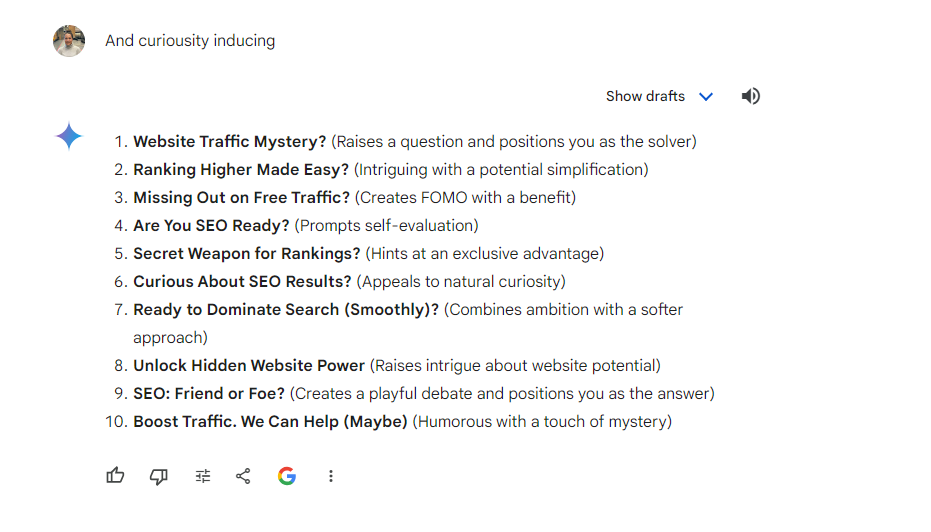
We know humans thrive on emotional triggers and Google Gemini can be great at approaching ad copy from this angle, which can encourage users to take action. While I wouldn’t directly probably use any of the above, what it does is give me inspiration for my own ad copy – invaluable if you’re looking to try something new for a client you’ve worked on for a while.
As a Large Language Model (LLM), Gemini can also help to strengthen existing ad copy and perform clarity checks – ensuring that content is clear and concise, or identifying areas where we can make our ads more compelling, or strengthen them for better impact. Even if you have existing ad copy it’s always worth asking Gemini for advice on how this could be strengthened or clarified.
2. Keyword research
Keyword research is one of the main areas you can use Google Gemini to save time, but the main benefit is its ability to create new paths of thinking, rather than just deploying the standard keyword build.
If I am looking to expand my targeting on the “seo agency” campaign I’m not just looking for a few words either side, I’m looking for new cluster topic ideas. Gemini is great for this as it can break the research down into keyword clusters.
From the outset, we can use Gemini to identify cluster-based themes for our keyword research, in the first instance focusing on high-intent keywords:
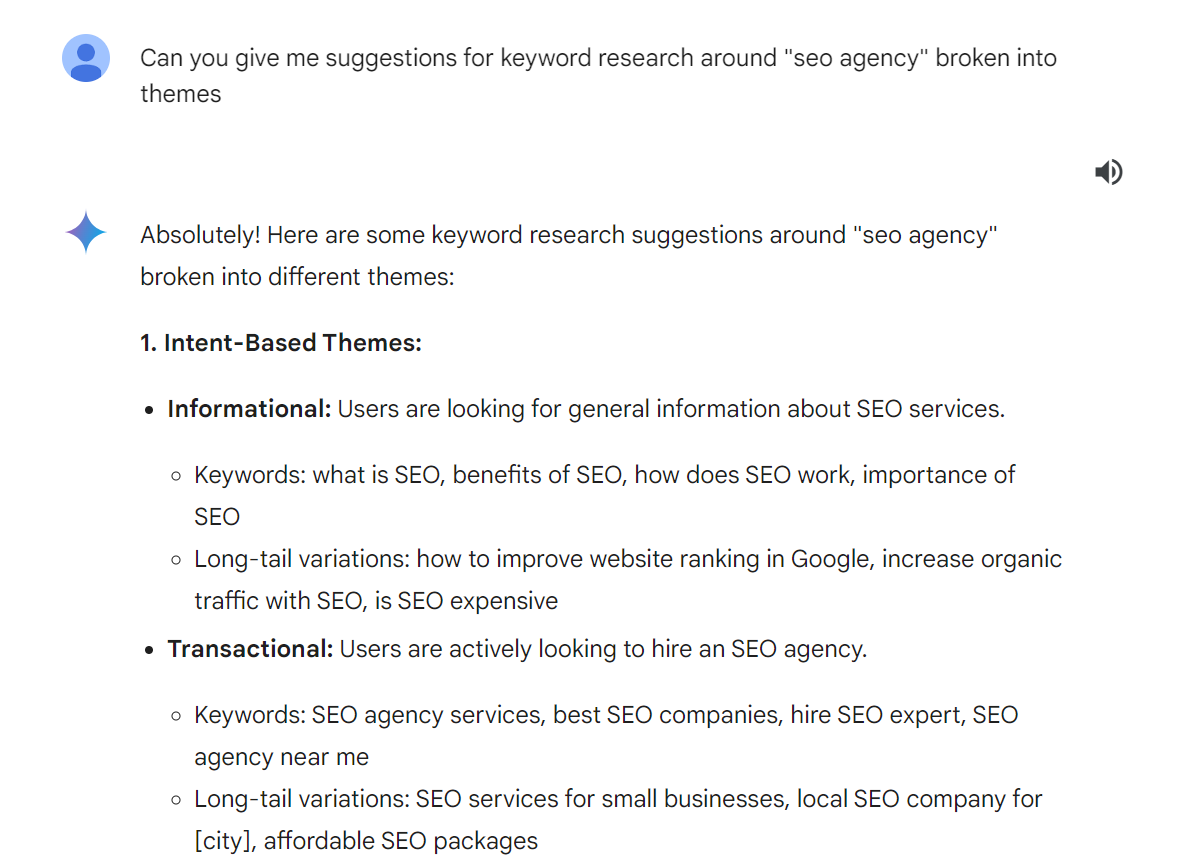
We can break these out further by looking at different clusters, including keywords which are industry-specific, location-based or service-based:
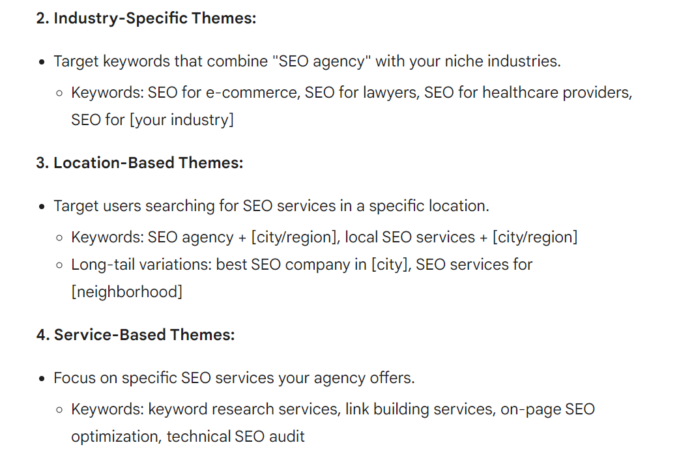
We can build these out further still by honing in on a specific vertical, which is great if you focus on a specific industry and can allow for further expansion of targeting within this area. In this instance we asked Gemini to focus on industry specificity:
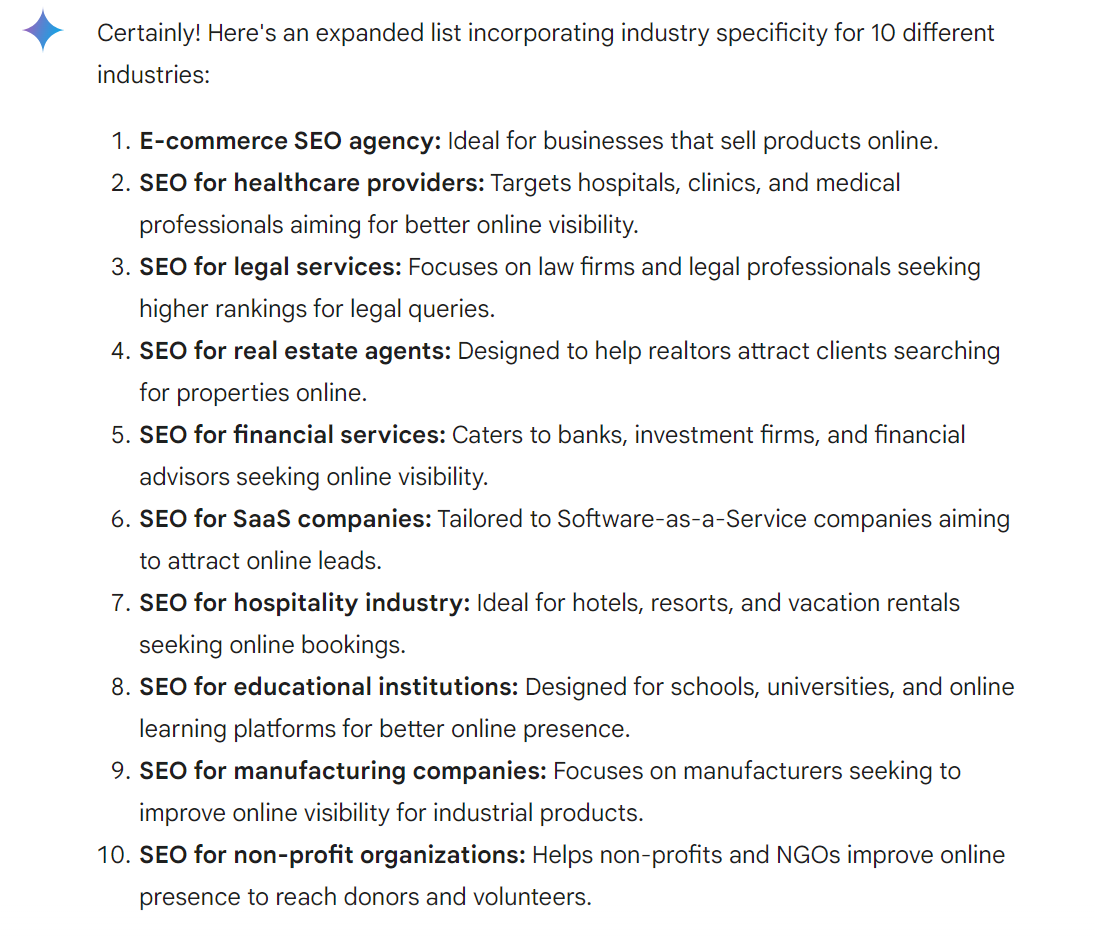
Gemini can be invaluable for building keyword lists out, but more than that it can be used as a tool for inspiration to get into very granular targeting of areas you might not otherwise have identified. This helps to build depth and increases focus on high-intent, low competition keywords.
3. Audience Personas
One thing Gemini does really well is bring data together in a quick and effective manner. If you are looking to undertake research this is one area it can really save you time.
Often at the start of a campaign you will be looking to build out audience personas. While in some instances you’ll be fortunate enough to work with brands who have this data to hand, if you aren’t in that boat then being able to dig out different persona data can be a time-consuming task.
With a few of the right prompts, Google Gemini can do that for us. In this instance, we asked Gemini to create some user personas for the watch brand, Watches2U. What came back was in-depth insights that got us thinking about the potential audience:
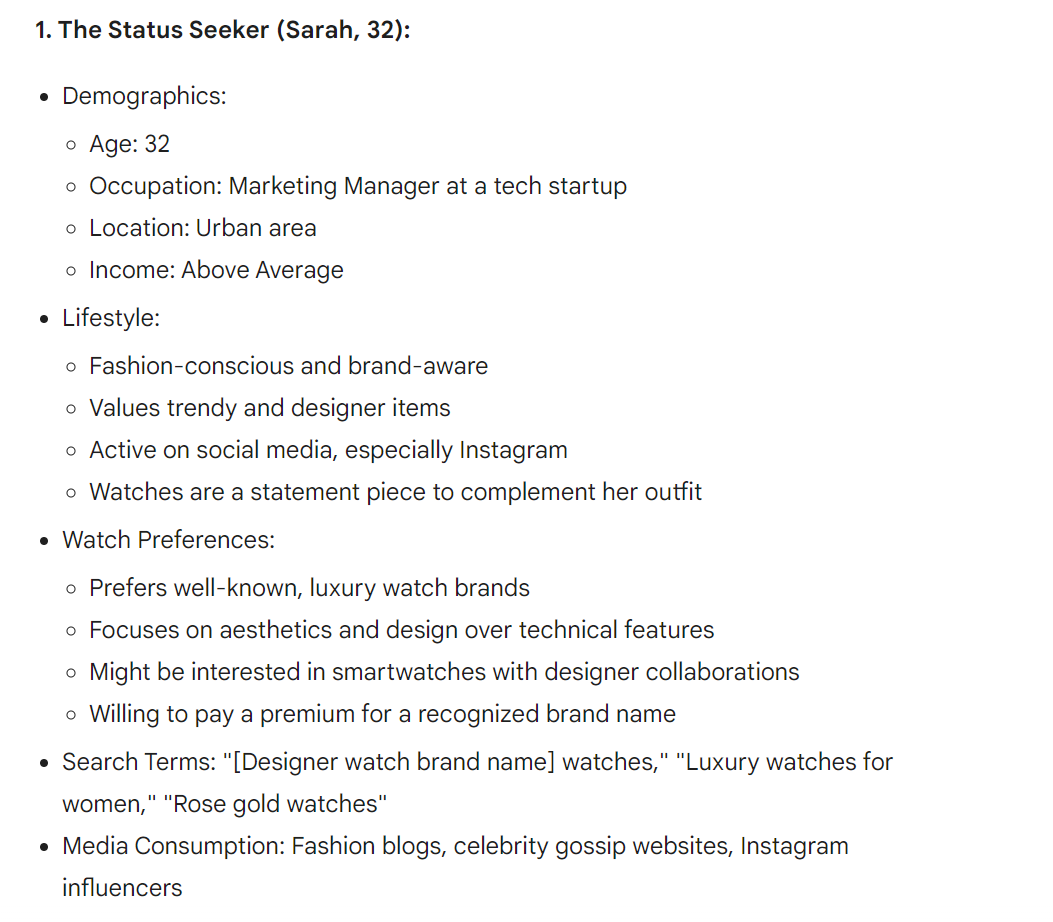

These are only two, of the six different personas Gemini offered, and which helped to define our audiences. When combined with our own internal data they gave us a thorough picture of what the watch marketplace looked like, helping to focus our ads.
It’s not just audience personas that Gemini can help with when it comes to audience research data. You can also use the data to understand some of the challenges your audience is facing, so that you solve their problems and answer their questions accordingly.
In this example, we asked Gemini to list the struggles of an audience who might be looking for an SEO agency:
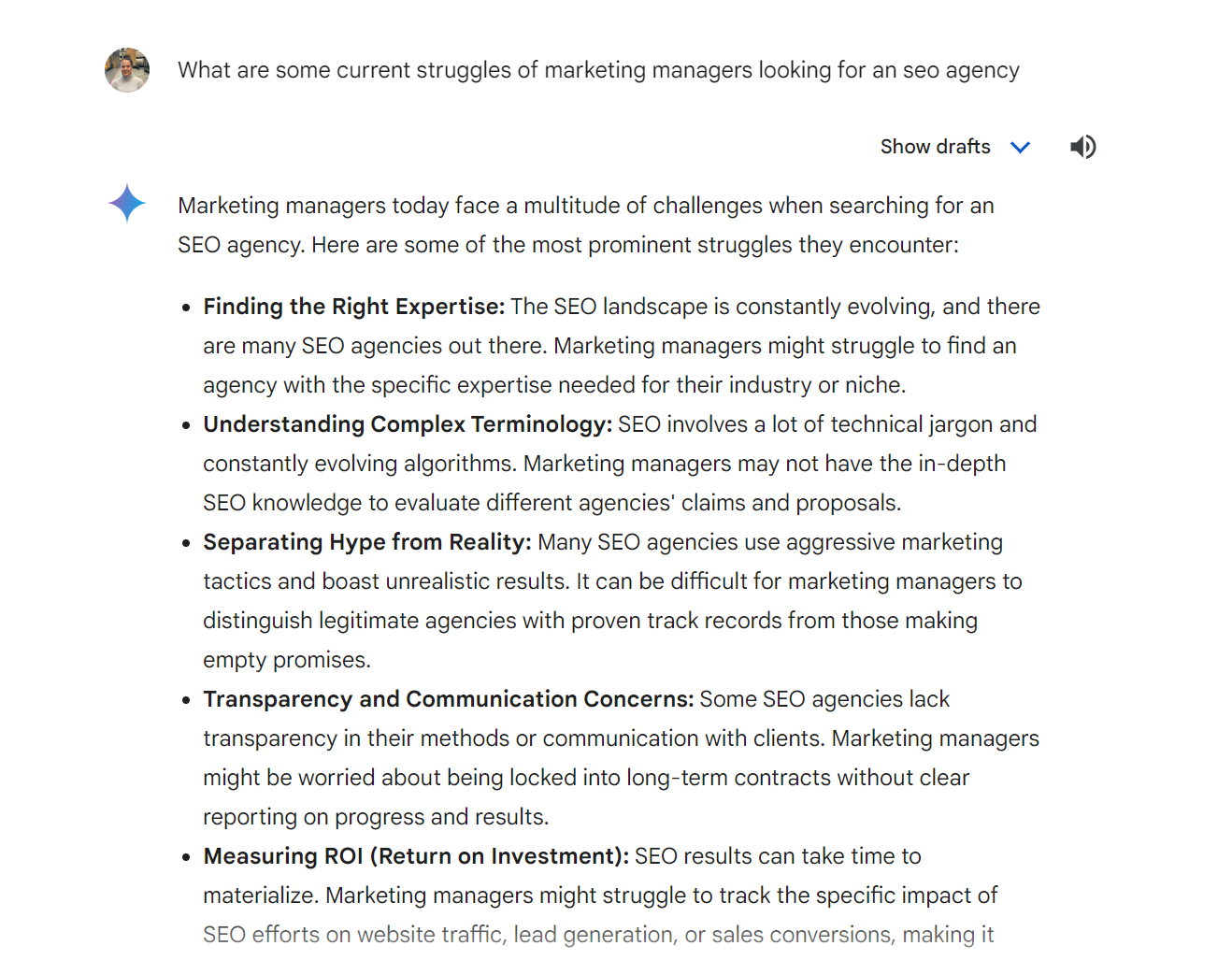
By understanding this data we can start to tailor our approach to ad copy, targeting and the landing page experience, ensuring we’re answering queries and addressing pain points from the outset.
You can also have Gemini evaluate your landing pages to identify potential opportunities for improvement, identifying areas that might resonate well with an audience, and also those which could take some improvement. In this instance, we asked Gemini to analyse our SEO landing page to see if it was appropriate for the audience we were targeting:
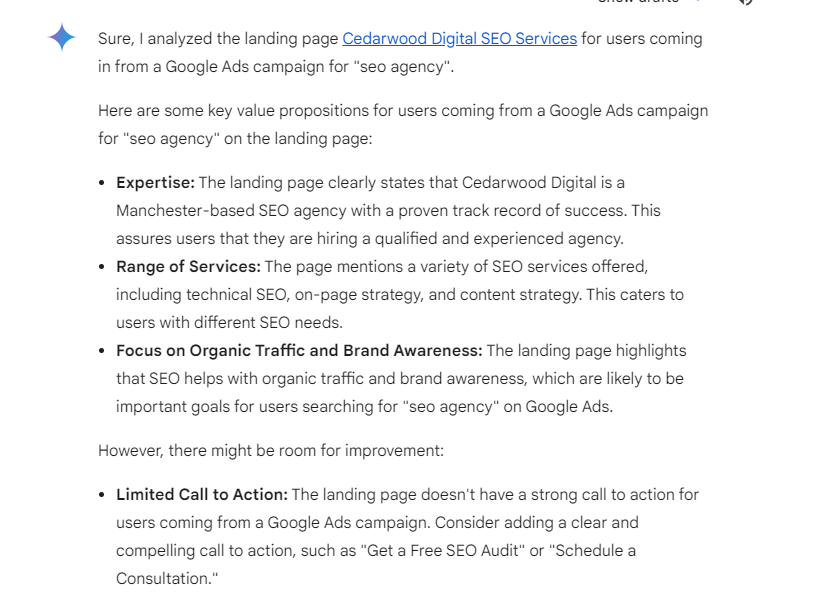
4. Negative Keywords
In addition to helping us to find keywords to target, Gemini can also help us to pre-emptively build negative keyword lists which can save us money from the outset.
Using a similar structure to the keyword research we can ask Gemini to group these into themes:

By understanding the intents we can build out targeted negative keyword lists to ensure we aren’t showing our ads to irrelevant close variants or phrase matches, which could burn through our budget.
As with the keyword lists we can expand on these individual intents to get more comprehensive keyword lists. In this instance by building out the “educational” list we can identify even more negative keywords and build out comprehensive lists in next to no time.

Many agencies have to start running campaigns with limited negative keyword lists due to time and budget constraints, leaving brands spending budget to simply find out what those keywords are before removing them from the campaign. By using Gemini in this way it enables you to build out a much bigger negative keyword list from the start, saving budget and time.
5. Troubleshooting Google Ads Scripts
If you’re a Google Ads Script user then chances are you understand the value of using scripts both to drive efficiency and save time.
There are a number of ways that you can use Gemini to help with scripts. While it can’t actually write the script itself it can help to troubleshoot potential issues and explain the different functionalities within Google Ads to support with script creation.
In the following example, we asked it to evaluate a script we use frequently called the “Exact Match Variant” script, designed to implement negative keywords across any search query that doesn’t exactly match the term.
By querying the script, we can ensure that it does exactly what we would expect it to. If we find an issue we can adjust the script accordingly.
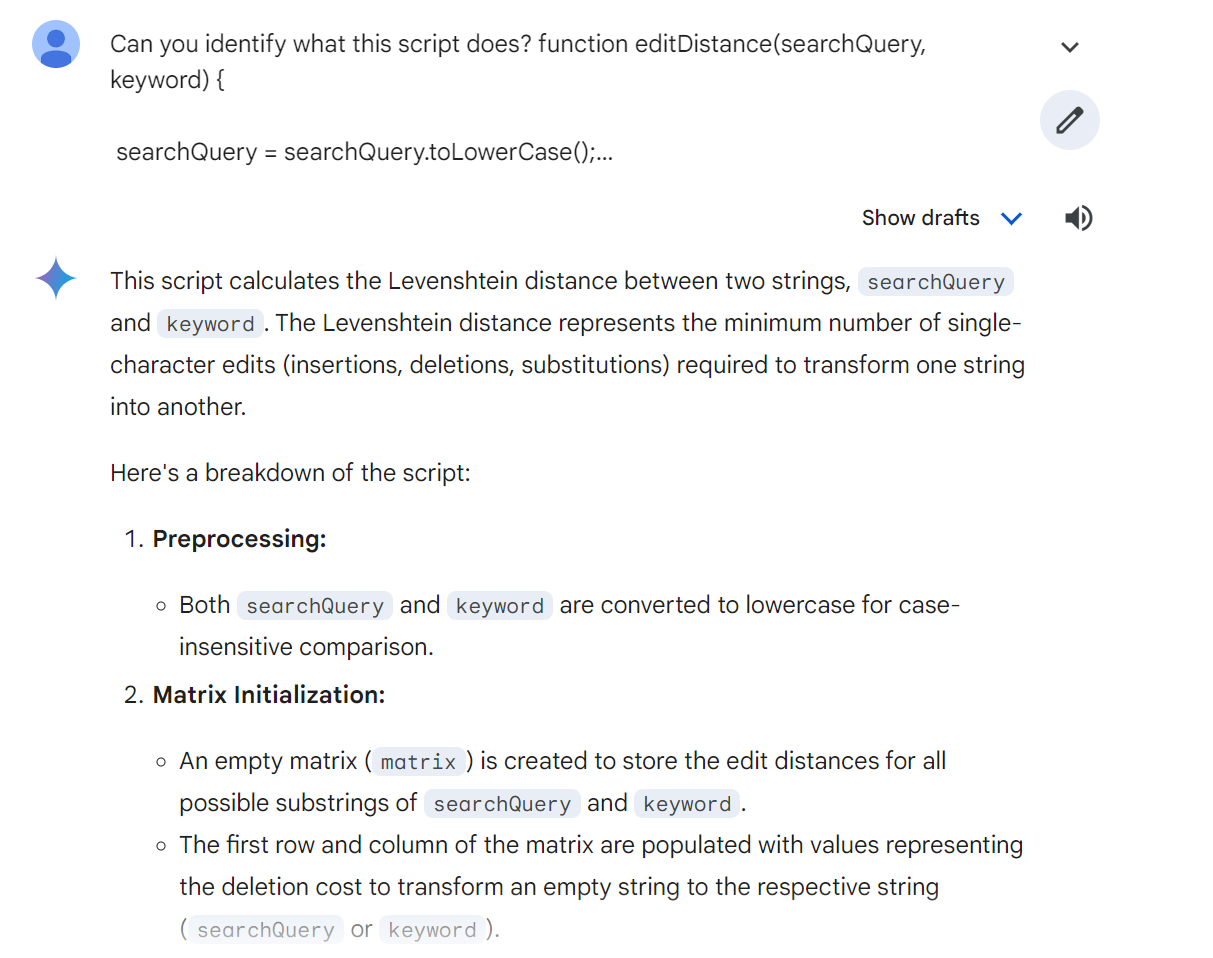
We can then ask Gemini to identify what the best practice use of the script would be and see that in accordance with our current usage it’s doing exactly what it should be:
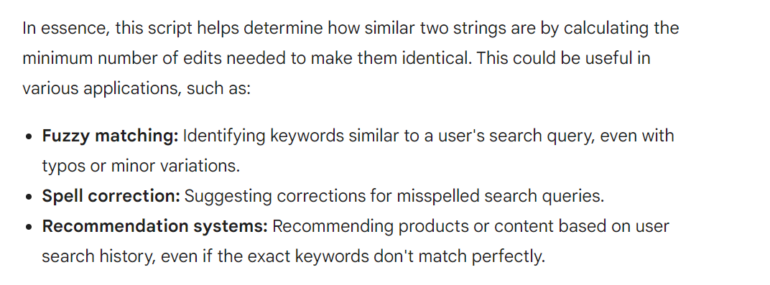
This can be invaluable if you want to try out a new script on a client’s account but want to ensure it’s working correctly before launching, if you simply want to better understand the functionality or make improvements to your existing scripts.
The above is not an exhaustive list, but provides a couple of ideas around how you can employ Google Gemini to improve efficiencies and depth across your Google Ads campaign. As AI continues to develop and expand, so will the opportunities to use it as an effective support tool across our marketing activities.
Amanda Walls is the Director of Cedarwood Digital – a performance marketing agency based in Manchester.
PPC
26 Ready-to-Go AI Prompts for Social Media

The digital age is evolving at lightspeed, and staying apace requires a special kind of savvy— especially for those in the throes of marketing. Artificial intelligence (AI) has stepped out of a sci-fi movie and into our daily communications, specifically in the world of social media. Marketers must now utilize AI to streamline their strategies and deliver their messages effectively for brand awareness.
Below, we’ll look closer at AI prompts that drive engagement on platforms such as Facebook, Instagram, and LinkedIn and how they’re revolutionizing the approach to social media content.
Contents
Understanding AI prompts for social media
To the new user, AI prompts may sound like techno-babble or a different language. But they are the keys to unlocking influential and personalized social media experiences. AI prompts are commands or signals that generate content or responses using AI technology. In the world of social media, they’re used to create posts, reply to comments, or even direct messaging.
Different platforms leverage AI prompts in a variety of ways, tailoring learning algorithms to suit their specific environment and user behaviors. What is the result? Heightened relevance and resonance within the social media platform’s intended audience. This means more likes, shares, and engagements–ultimately, an increase in brand visibility and potential customer conversion.
When it comes to writing social media content, using AI prompts can up-level your approach. By understanding how these prompts work and incorporating them into your strategy, you can create more impactful and personalized posts.
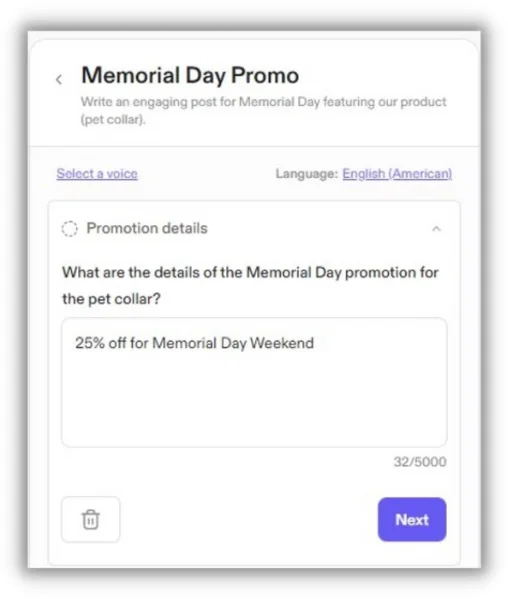
At first, AI prompts may seem like a foreign concept. However, they are simply commands or signals that use artificial intelligence technology to generate content or responses. Essentially, they allow you to communicate with the platform’s algorithms to create tailored content for your audience.
Each social media platform utilizes AI prompts in different ways, depending on their specific environment and user behaviors. This allows the AI technology to learn and adapt to each platform’s audience.
🚨 Get copy-and-paste social media posts ready for the whole year in our free social media calendar template!
Benefits of using AI prompts for social media
Why integrate AI into your social media campaigns? Firstly, AI prompts offer incredible time-saving benefits. They generate responses in real-time, allowing community managers to focus on strategy rather than mundane and tedious tasks.
Secondly, there is improved engagement; AI prompts can provide instantaneous, relevant content to users, keeping up with the fast-paced demands of digital conversation.
Last but certainly not least, they allow for personalized interactions. AI can analyze vast amounts of data to tailor messages according to individual preferences, ensuring that content strikes a chord every time it’s posted.
How to create effective AI prompts for social media
Crafting AI prompts is an art form in itself. Be clear about what you want to achieve with your social media post. Is the goal to drive traffic to a website, increase product sales, engage with a particular audience, or boost brand awareness? Your objective will heavily influence the formation of your prompt.
AI operates best with clear and specific instructions. For instance, rather than saying “create a post,” provide more details like “create an informative post about how our products are made with eco-friendly practices.” The specificity assists the AI in understanding the direction of the content.
Make sure to set the tone and style–professional, informal, friendly, authoritative, humorous, etc. This helps ensure the content resonates with your intended audience and upholds your brand’s identity.
“In crafting AI-driven content for social media, providing clear and precise directives creates compelling narratives. Whether your business is centered around healthcare, retail, or a charming and quiet local cafe, being explicit about your content needs, especially the social media platform in question, ensures resonance with your audience,” said Frederick Hill, Social Media Manager and Team Lead at LocaliQ.
“Always conclude with a clear call to action, inviting engagement and connection. Remember, specificity is not just a detail, but the strategy for your brand’s impactful communication.”
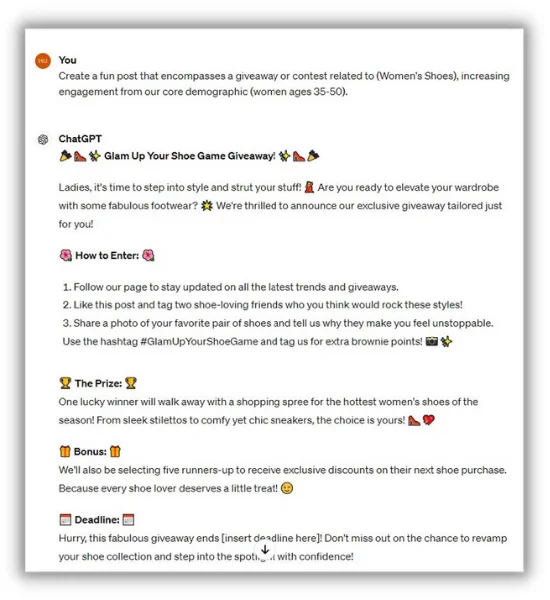

To effectively launch your AI prompts, consider these best practices:
- Know your audience: Understand the demographics, interests, and behaviors of your followers to tailor content effectively.
- Stay authentic: AI should enhance your brand’s voice, not replace it. Maintain your tone and values in every prompt.
- Monitor performance: Use analytics to assess the success of AI-driven posts and refine your approach accordingly.
Businesses like Starbucks and Sephora have leveraged AI for engaging social media prompts, from holiday-themed posts to interactive challenges. Even B2B companies use AI-driven insights to produce blog posts that are thought leaders in their industry.


📚 Free guide download >> 135 of the Best Words & Phrases for Marketing with Emotion
26 AI prompts for social media
AI can transform your social media strategy. From Facebook to LinkedIn, X, and Instagram, enhance your business’s online presence with these expertly crafted AI prompts.
AI prompts for Facebook
For Facebook, prompts must be engaging yet conversational. AI should humanize the brand and invoke meaningful interactions. For instance, AI prompts for a product launch on Facebook might ask users for thoughts on a problem your product solves, generating individual responses that maintain the thread of conversation.
Use some of these AI prompts for Facebook:
- Craft a humorous Facebook post about a (topic) that sparks engagement and conversation.
- Create a Facebook post that asks our core audience to share their favorite memory or experience using (insert your brand name or product). Write it in a zealous tone of voice.
- Create a fun post that encompasses a giveaway or contest related to (brand/topics), increasing engagement from (target audience).
- Draft a post unveiling (number) captivating insight about (topic).
- Write an engaging post that asks (target audience) to share their thoughts on (content piece or a new product).


AI prompts for Instagram
Visual reigns supreme on Instagram. Your AI prompts here need to encourage actions that align with compelling imagery–think hashtags, emojis, and comments that mirror the visual narrative. Generating personalized AI-driven Instagram captions or comment responses can deeply enhance the user experience.
Use some of the AI prompts for Instagram:
- Write a few Instagram photo captions for a picture (photo description).
- Create an Instagram poll or quiz related to (brand/product/service).
- Engage the brand’s ideal customer (insert demographic/persona) with a message that leads to (desired action).
- Craft an Instagram message that showcases a behind-the-scenes look at a new campaign coming out soon.
- Create excitement and anticipation for a new product launch or services to engage with my customers and attract new customers.
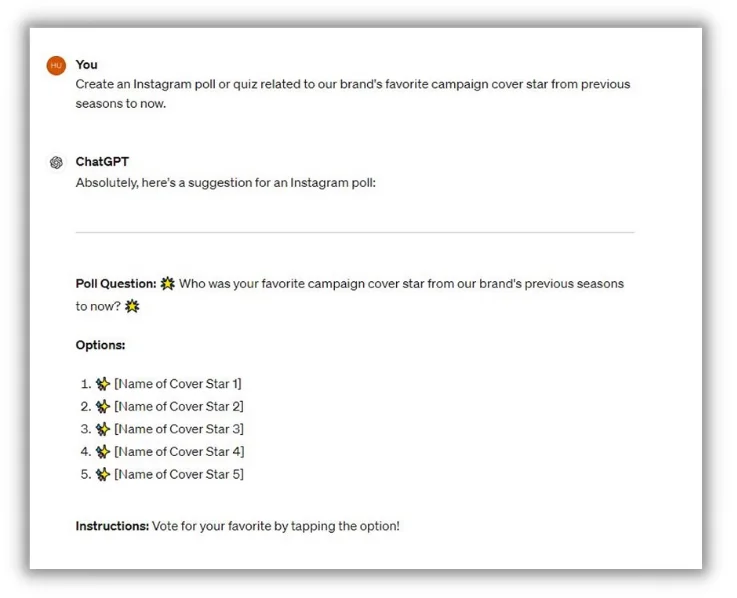

AI prompts for LinkedIn
LinkedIn favors professionalism and thought leadership. Your AI prompts here should stimulate intellectual engagement, like career insights or industry news discussions, always keeping a tone consistent with the professional atmosphere of the platform.
Use some of these AI prompts for LinkedIn:
- Generate a LinkedIn post about the brand’s involvement in giving back to the community and volunteering.
- Write a LinkedIn post about your brand and its employees participating in webinars, conferences, and panel discussions.
- Create a LinkedIn post about the brand’s accomplishments and highlights.
- Craft a LinkedIn post highlighting a specific (industry trend/news) and how it is relevant to your brand.
- Create a LinkedIn post highlighting top performing leaders and their success stories.
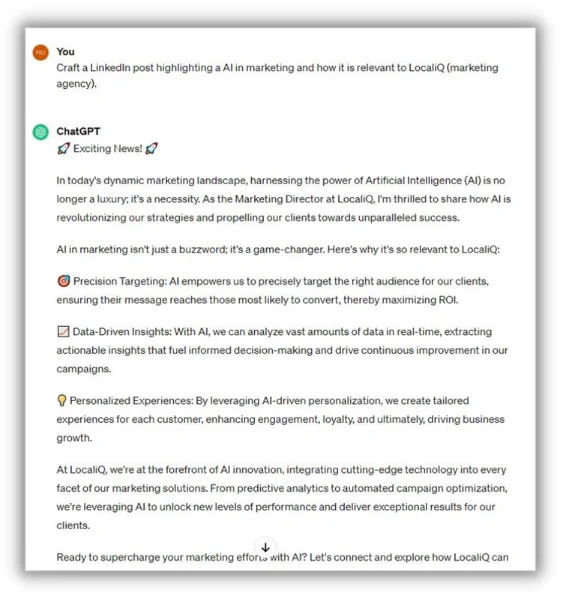

AI prompts for X (formerly Twitter)
X’s brief and clever nature means your AI prompts should be concise and impactful. Crafting questions or prompts that are easily retweetable and require just a quick reaction can maximize your reach and engagement.
Use some of these AI prompts for X:
- Write a thread showcasing the evolution of (industry or brand) over the past (amount of time).
- Introduce the team behind (brand or product) and share their journey and story.
- Discuss the brand’s mission and vision while aligning their cultural values that drive the company.
- Share a thread on key moments and highlights that defined the brand’s evolution.
- Craft a post introducing new collaborations and partnerships with (brand). Describe the significance of the collaboration.
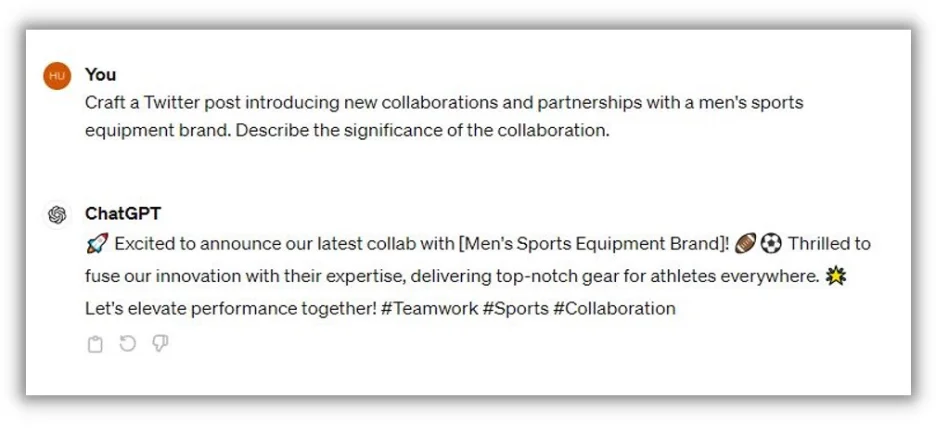

Holiday-themed AI prompts for social media
Fun and holiday-themed AI prompts for social media also spark joy and create memorable moments that make your brand relatable and human.
Use some of these AI prompts for holiday and fun posts:
- Brainstorm a list of (holiday) themed posts that I can use for Instagram and Facebook.
- Draft a Facebook poll asking your target audience what they like most about (holiday).
- Craft a holiday-themed giveaway or contest on (Instagram, Twitter, Facebook) for (brand/product/service).
- Write a funny and witty social media post about (topic).
- Draft a social media post asking your target audience to share their favorite moment with (brand/product/service).
- Write a fun and positive social media post that that features an inspiring story related to (brand/product/service).
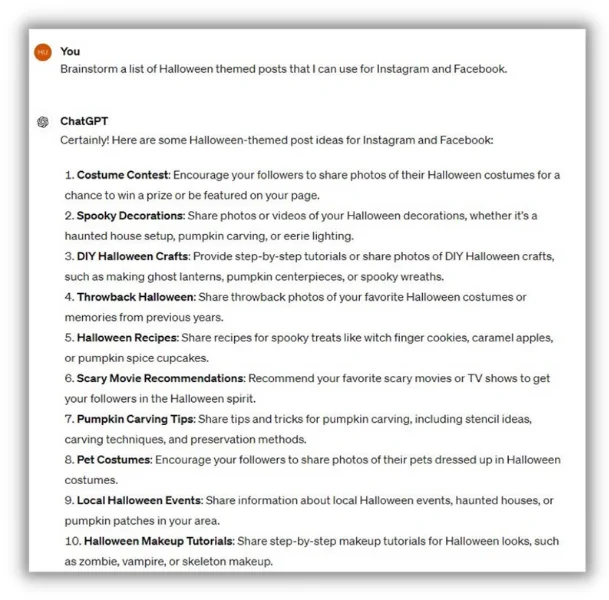

Create engaging posts using these AI prompts for social media
The integration of AI in your social media strategy isn’t just wise; it’s becoming essential. By crafting mindful prompts tailored to your audience, you can create a dynamic and engaging online presence. The goal is to not only be heard in the abundance of digital voices but to get your message across to the right audience.
By investing time and resources into utilizing AI for your social media initiatives, you’re not just keeping up with the trend–you’re riding the wave of the future and setting your brand up for deeper connections, an expanded audience, and ultimately, greater success.
The next chapter for your brand’s story begins now, shaped by the ingenious use of AI to craft messages that resonate, inspire, and endure. Now, go forth and curate prompts powered by AI that will inspire your community, one post at a time!
-

 SEARCHENGINES7 days ago
SEARCHENGINES7 days agoGoogle March 2024 Core Update Finished April 19, 2024
-

 MARKETING6 days ago
MARKETING6 days agoNavigating the Video Marketing Maze: Short-Form vs. Long-Form
-

 SEO7 days ago
SEO7 days agoGoogle March 2024 Core Update Officially Completed A Week Ago
-
![The Current State of Google’s Search Generative Experience [What It Means for SEO in 2024] person typing on laptop with](https://articles.entireweb.com/wp-content/uploads/2024/04/The-Current-State-of-Googles-Search-Generative-Experience-What-It.webp-400x240.webp)
![The Current State of Google’s Search Generative Experience [What It Means for SEO in 2024] person typing on laptop with](https://articles.entireweb.com/wp-content/uploads/2024/04/The-Current-State-of-Googles-Search-Generative-Experience-What-It.webp-80x80.webp) MARKETING7 days ago
MARKETING7 days agoThe Current State of Google’s Search Generative Experience [What It Means for SEO in 2024]
-
SEARCHENGINES6 days ago
Daily Search Forum Recap: April 26, 2024
-

 WORDPRESS6 days ago
WORDPRESS6 days agoNew WordPress.com Themes for April 2024 – WordPress.com News
-
SEARCHENGINES3 days ago
Daily Search Forum Recap: April 29, 2024
-

 SEARCHENGINES5 days ago
SEARCHENGINES5 days agoOffline For Last Days Of Passover 5784















